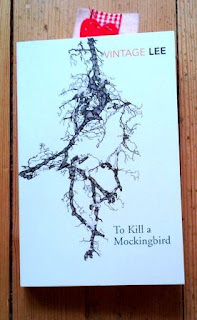Midwinterblood by Marcus
Sedgwick
Midwinterblood has been
shortlisted for the Carnegie Medal 2013.
Midwinterblood is the only title on this year’s Carnegie shortlist
that I have read after its shortlisting was announced. This puts it at an
unfair advantage or even disadvantage in the way I’m going to review it,
especially since I reviewed some of the others before the longlist
was even out.
 |
| The cover on my copy |
So, Midwinterblood. I didn’t pick it to read from the longlist
– mostly because of the cover. Also, from what I’d seen, Marcus Sedgwick was mostly a
horror-fantasy author, genres I usually avoid now (although maybe not when I
was a teen). If it is horror-fantasy that you’re after, Midwinterblood
delivers. However, it offers up something much more than chills or gore (thankfully
for me, the latter was not in undue abundance) and I was very pleasantly
impressed.
Note the different covers: I think the newer cover (see below), not the one on my copy (see left), fits my interpretation of the novel better.
Midwinterblood is an unusual novel and quite different from
anything I remember reading for teens (there is plenty that I have not read though). Quite simply, it tells the story of Eric
Seven and Merle and how they know each other. But, it is much more exciting
than that and it is also not quite as straightforward as that. Inspired by a
real painting (which features in the novel), the story is divided up into eight
parts and told in chronological reverse. Each part tells a separate story that
can be read on its own. But together, the stories work to weave together what might
be seen as something akin to a folkbook.
 |
| New cover; I prefer this one. |
The novel’s blurb and other reviews have identified strong
themes of love and sacrifice in the novel. Of course yes, they’re there in many guises. After
reading Part 1, I thought Midwinterblood might follow similar plotlines to Audrey Niffenegger's The
Time Traveler’s Wife – love that builds and endures against the odds against
and through time. In some ways, it does, but in many ways it doesn’t and it
certainly isn’t as romantic (in my view).
The themes and ideas that stood out for me most were
personhood, permanence/longevity and roles. What is a person? If you change one
thing, like their sex, are they the same person? The novel certainly delivers
many discussion points.
Midwinterblood also defies some of the suggested criteria
that we’ve been using for shadowing. This either marks the novels strengths or
its weaknesses.
I think it is weak on narrative and feels more like a
collection of stories that read like different interpretations of fairytales
(or myths) over time and space, enveloped by the original frame story in Part 1
and Part 7. But, the Epilogue belies what I’ve said and indicates that there is
a narrative (in my mind, only just a weak one). Although only chronologically
reversed, the narrative development is still non-linear – I couldn’t spot real
plot or character growth. Did I miss it? However (again!), the narrative and
plot structure are also possibly the novel’s key strength.
(Careful: for some people there may be a very small SPOILER in
the following paragraph: I don’t think it is but some might.)
Sedgwick’s writing style is sparse. He doesn’t overly describe
anything, which I like. But I think this also contributed to weaker
characterisation. I didn’t empathise with any of the characters. Perhaps too,
this was the point of the novel: we are not just one individual, we are many people.
This bit is interesting because the characters take on different relationships
with each other throughout the novel and that in itself addresses many taboos
about acceptable relationships. The change in narration is also interesting to
consider in terms of how that might affect characterisation: the novel is
written in the third person, other than Part 6.
(End of small SPOILER. You may proceed without fear.)
Midwinterblood is an allegorical novel. Its inspiration
comes from a painting (which is featured in the novel – there’s a whole part
centring on it) and there is plenty of symbolism and allegory in the novel that
could point curious readers to ideas about philosophy and religion (like Nietzsche
and eternal return) as well as literature. When I was reading, there was always a sense that the
novel was following, considering, contemplating, pointing me to something else.
I’d expect this novel to prompt further questioning and research enquiry by the
most curious of readers.
I read Midwinterblood quickly and I wanted to read it. It
wasn’t so much that I was absorbed into the story but rather that I was curious
to see how it would all pan out. This novel has many talking points, not least
of which are its form and readers’ expectations. In my mind, it scores many
bonus points for doing that.
For suggested teens reads, Midwinterblood offers a wonderful
thought-provoking alternative to Twilight. It is also a quick read. For
educators, talk about a novel that is both popularly contemporary yet cuts
easily and effortlessly across the curriculum.....history (Vikings, World Wars,
cyclical/linear, architecture), art, geography, religion and philosophy,
literature, science, citizenship: they’re all there.
It is probably more suitable for Year 7 plus although advanced (and interested) readers in Year 6 might enjoy it.
If you enjoy the interlinked his-stories of Midwinterblood,
you may well like Nick Lake's In Darkness (another Carnegie shortlisted title!) or Cloud Atlas by David Mitchell (an adult novel with mixed and much more dense writing styles).
Publication details: Indigo, 2011, London, paperback
This copy: given to us as a prize.
PS. You can win a copy of Midwinterblood with the new cover over here if you are in the UK and enter before 19 May 2013.



















